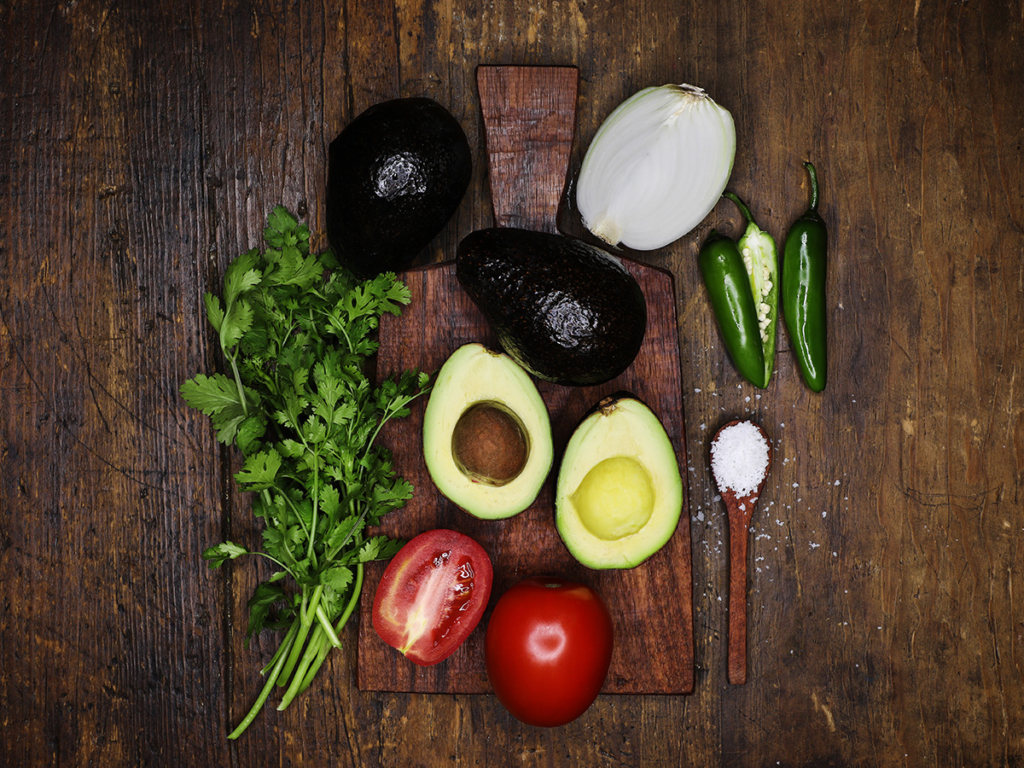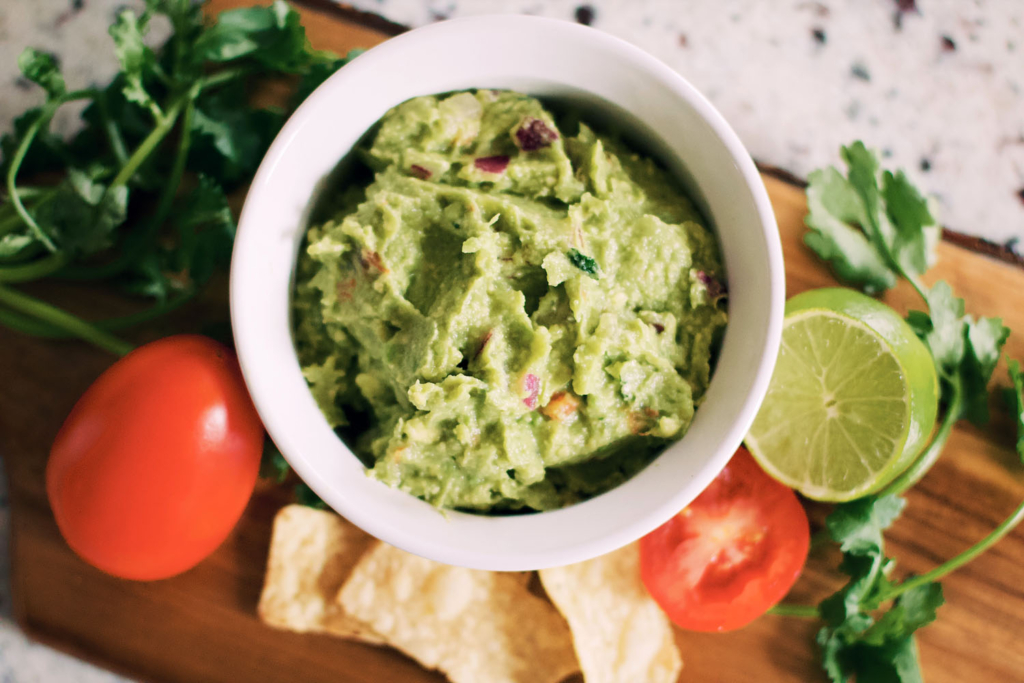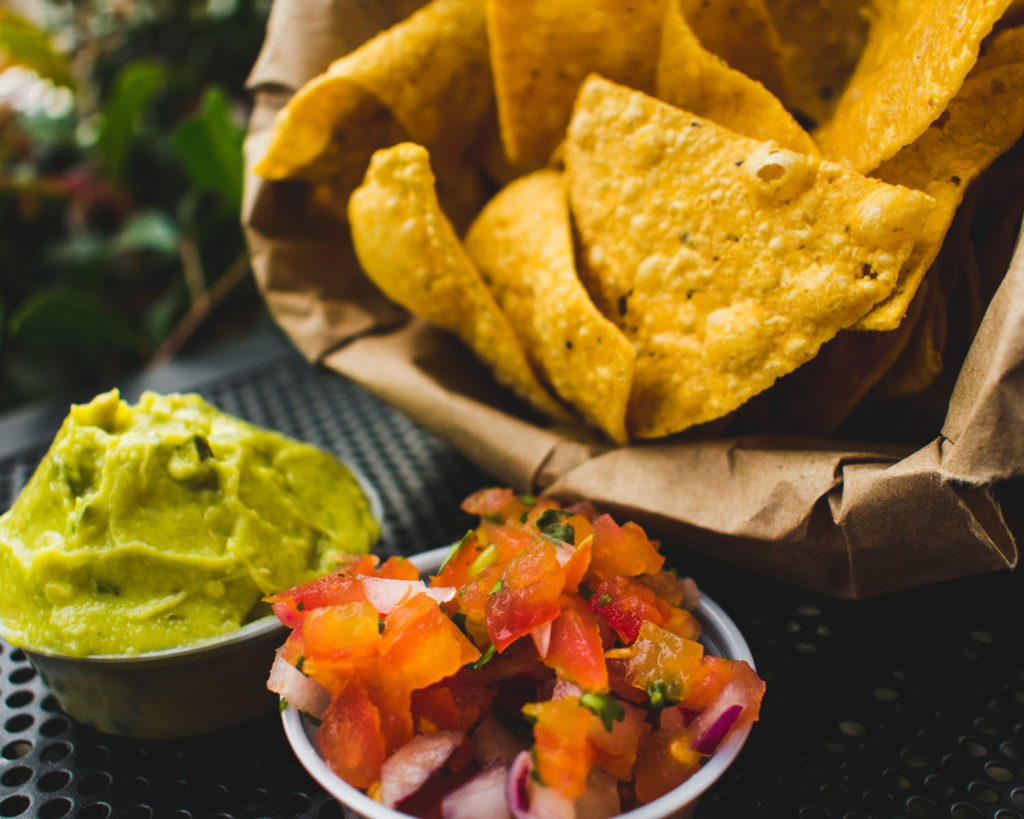Guacamole is the iconic Mexican avocado dish, and like all iconic dishes, it has attained that status because it is an integral part of the nation’s cuisine – and the nation’s cooks have perfected it.
When prepared in a traditional molcajete (a Mexican lava-stone mortar and pestle), the taste, texture and experience of guacamole cannot be improved upon, even though the dish contains but a few simple ingredients. You can adjust a little, tweak it here and there, but no great new revelations are going to come of it. Guacamole is perfect.
A Harmonious Blend
Originally, guacamole was prepared using only mashed-up avocados, but over time, other ingredients that we now associate with the condiment were incorporated. The recipe is a combination of ingredients native to the Americas, including avocado, tomato and peppers, along with a few introduced by the Spanish, such as onion and cilantro.

[Photo by Andrés Carnalla]
Today, guacamole is a medley of ripe avocado, plum tomatoes, white onion, serrano peppers, cilantro and a pinch of salt. The creaminess of the avocado, the slight fruity sweetness of the tomato, the sharpness of the onion, a little heat from the serrano peppers, and the herbal backdrop of the cilantro work harmoniously together to create a dish where the result is greater than the sum of its parts.
Look closely, and you’ll notice that nearly all recipes for guacamole have similar ratios of ingredients. Every cook adapts the dish to their taste and will argue that their version is the ‘correct’ way to make it, but the balance of ingredients remains nearly the same. You can think of the core ingredients like the mathematical golden ratio, the ‘divine proportion’ seen in nature, art and architecture. As a dish, guacamole is indeed divine.
Guacamole: Origins And Traditions
Having been cultivated and consumed in Mexico for more than 5,000 years, avocados are an integral part of its cuisine. The name guacamole comes from the Nahuatl language used by the Aztecs, derived from the word ‘ahuacatl’ (avocado) + ‘molli’ (sauce) which became ‘guacamole’ in Spanish. You might be familiar with mole sauce, which many people associate with the Mole Poblano, aka the ‘chocolate sauce’, but the term ‘mole’ is actually applied to many different sauces. There are red moles, green moles and black moles – or, in this case, avocado mole.
Think of guacamole as Mexican comfort food with a sense of place. It’s unpretentious, feels like home and makes you happy. It’s even comforting to prepare: once you’ve made it so many times, the preparation of it takes on a beautiful meditative rhythm. You no longer think about it. It just comes together deliciously and effortlessly. Chop, salt, mash, blend, enjoy.
How best to enjoy it? With others, of course. Food culture in Mexico is hospitable; you joyously share what you have, and food is always involved when people get together. Guacamole is a hospitable dish you can quickly put together when someone drops by unexpectedly (which happens often here). It’s also perfect to take when you get together with friends, family and coworkers (which is also often).

Many people think of guacamole as a party dip, but in Mexico, it is an everyday dish – though it is also served at parties. In my house, as in most, we eat it three or four times a week. It’s a quick afternoon snack, a light lunch or dinner. We eat it wrapped in fresh corn tortillas, scooped up with tortilla chips, or spread on tostadas. We also like to use it as a salsa, especially for carne asada (grilled beef steaks).
Regional Flavours
Guacamole does have some unique regional variations: One that I enjoy in particular is Chamacuero-style guacamole from the town of Comonfort in Guanajuato. It is prepared with diced peaches, pomegranate seeds and grapes. Chamacuero is the original name of the town, located 20 minutes from San Miguel de Allende where I used to live.
Other variations of guacamole I have enjoyed are prepared by substituting mango, watermelon or pomegranate seeds for the tomato, which gives it a sweeter, fruitier and much lighter taste. My personal favourite, however, will always be the classic version.
How To Make The Perfect Guacamole
Source Fresh Ingredients
As with all Mexican dishes, fresh ingredients are key when preparing guacamole. The flavours of hard avocados, unripe tomatoes or tired cilantro have no place to hide. Sourcing perfectly ripe avocados can be tricky, but when you shop at the local markets in Mexico, you can ask the vendor for avocados ‘for today’ and they will choose for you fully ripe avocados ready to prepare immediately. If you want the avocados for another day, just ask for ‘tomorrow’ so that they are at the perfect point of ripeness when you are ready to use them.
But perhaps you don’t have an expert Mexican avocado vendor to consult, and must choose them yourself. You want avocados that are just slightly firm, not mushy. To check if an avocado is ripe, use your thumb and gently push on the top of the avocado where the stem connects (the narrower end of the avocado). The flesh should give a little. If the avocado is hard and doesn’t give when pressed, it isn’t ripe and will make your guacamole bland with poor texture.

Avoid Extraneous Seasonings
A true Mexican guacamole will never have any sort of seasoning pack or spice mix added. Nor will it contain lime juice. They just aren’t necessary. Added seasonings overpower the flavour of the fresh ingredients, which need to be able to speak for themselves.
Use A Molcajete
To get the absolute best guacamole possible, you want to prepare it in a molcajete, which builds the flavours in layers. First, you grind the onion, serrano peppers and cilantro into a paste, which releases their volatile oils. Then, you incorporate this paste with the avocado, which permeates your guacamole with the flavours of the vegetables. Lastly, you mix in the tomato, which adds a fruity top note. Another benefit of grinding the paste is that it takes on a beautiful dark green colour from the cilantro, which enhances the look of the dish.
When you prepare guacamole without grinding the onion, serrano peppers, cilantro and avocado together, your guacamole will lack depth. Instead of complex integrated flavours from the ingredients, you get a more simplistic mixing of individual flavours when you take a bite. It’s still delicious, but doesn’t live up to its full flavour potential.
If you don’t have a molcajete, use a fork to mash the onion, serrano peppers and cilantro to release the oils. This will also create a delicious guacamole.
Classic Guacamole Recipe
Serves 4 to 6
Ingredients:
3 medium Haas avocados
1 plum tomato
1/4 medium white onion
2 serrano chiles
5 sprigs cilantro (about 3 tbsp. chopped)
1/2 tsp. sea salt + to taste

Instructions:
1. Pit the avocados by cutting them in half lengthwise then break into two halves and remove the pit.
2. Remove the seeds and veins from the peppers and finely chop.
3. Finely chop the onion and cilantro.
4. Remove the seeds from tomatoes and dice into quarter-inch cubes.
5. In a molcajete, grind the onion, serrano pepper, cilantro and salt into a paste.
6. Scoop the flesh of the avocado into the molcajete and mash.
7. Spoon in the chopped tomato and stir to evenly incorporate.
8. Adjust the salt to taste.
Notes:
– If you don’t have a molcajete, use a medium-size mixing bowl and a fork to mash the ingredients.
– Always work with the freshest ingredients available.
– Use white onion or red onion in your guacamole, but never yellow onion. The flavour and texture aren’t the same.
About the Author: Douglas Cullen is the publisher of the Mexican Food Journal and a resident of Mexico for 25 years.
About the Photographer: Andrés Carnalla is the Creative Director for the Mexican Food Journal. He was born in Cuernavaca, Morelos.














Sorry, the comment form is closed at this time.